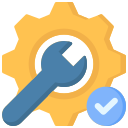Key Takeaways
- Optimize images and media to reduce file sizes, utilizing compression tools and considering lazy loading for enhanced performance.
- Implement caching solutions, both page and browser caching, to significantly improve load times for repeat visitors.
- Choose a hosting provider that offers WordPress-optimized server configurations to ensure high speed and reliability.
- Minimize the use of plugins and themes, keeping only what’s necessary, to reduce the extra load on your website.
- Regularly measure and monitor your site’s speed using tools like Google PageSpeed Insights and GTmetrix, and apply their optimization recommendations.
If you need wordpress speed optimisation services for your website do not hesitate to contact us and check our services. With over 12 years of experience in developing wordpress websites we can help with anything.
Read below to find out the best wordpress speed optimisation tips:
Introduction
In today’s fast-paced digital landscape, the speed of your WordPress website can make or break your online presence. Users expect lightning-fast load times, and search engines prioritize speedy sites in their rankings. Understanding and implementing speed optimization techniques is not just beneficial; it’s essential. This guide will walk you through the crucial steps to ensure your WordPress site performs at its best in 2024.
Speed optimization goes beyond improving user experience. It directly influences your website’s search engine optimization (SEO) rankings, engagement rates, and conversion metrics. With the right strategies, you can significantly reduce bounce rates and boost your site’s overall performance. Let’s dive into how you can achieve these goals with effective WordPress speed optimization techniques.
Understanding WordPress Speed
Why Speed Matters
The significance of website speed cannot be overstated in today’s digital age. Fast-loading websites not only provide a better user experience but also rank higher in search engine results. Moreover, speed impacts your site’s bounce rate, with slower sites seeing a higher abandonment rate. Essentially, the quicker your site loads, the more likely visitors are to stay and interact with your content.
Speed also plays a pivotal role in mobile browsing, where users often encounter varying network speeds. As mobile usage continues to rise, optimizing your WordPress site for speed becomes even more critical. This ensures that your content reaches a broader audience, regardless of their device or connection speed.
Common Causes of Slow WordPress Sites
Several factors can slow down a WordPress site, including web hosting, page size, unoptimized images, and excessive use of plugins. Poorly configured hosting can lead to slow response times, while large page sizes and unoptimized images can significantly increase loading times. Additionally, each plugin you add introduces additional resources that your site must load, which can also impact speed.
To tackle these issues, start by evaluating your hosting solution, optimizing images for the web, and assessing the necessity of each plugin. Reducing page size and minimizing the number of plugins can dramatically improve your site’s performance. Understanding these common culprits is the first step towards a faster WordPress site.
Key Strategies for WordPress Speed Optimization
Choosing the Right Hosting Service
Selecting the right hosting service is paramount for WordPress speed optimization. Not all hosting providers are created equal; some offer environments specifically optimized for WordPress. These specialized hosting services can significantly enhance your site’s speed and reliability. When choosing a host, consider factors like server location, resource allocation, and scalability options.
A good hosting provider not only improves site speed but also offers better security and support. Look for hosts that provide SSD storage, ample bandwidth, and advanced caching mechanisms. These features are crucial for ensuring that your WordPress site loads quickly and runs smoothly, even during traffic spikes.
Implementing Caching Solutions
Implementing caching is a game-changer for reducing WordPress site load times. Caching stores copies of your site’s content to serve to visitors without querying the database each time, dramatically improving speed. There are various caching solutions available, including plugins and server-side options, each designed to make your site faster and more efficient.
When configuring caching, focus on both page caching and browser caching. Page caching stores static HTML versions of your pages, while browser caching saves elements like stylesheets and images in the visitor’s browser. By effectively using caching, you can ensure that repeat visitors experience even faster load times, enhancing user satisfaction and engagement.
Optimizing Images and Media
Images and media files often account for the bulk of a website’s size, making optimization crucial for speed. By compressing images and using the correct file formats, you can drastically reduce file sizes without compromising quality. Tools and plugins are available to automate this process, ensuring all images on your WordPress site are optimized for speed.
Additionally, consider implementing lazy loading for images and videos. This technique loads media files only as they come into the browser’s viewport, reducing initial page load times. Lazy loading is especially beneficial for pages with a lot of visual content, making it a key strategy for improving overall site performance.
Minimizing Plugins and Themes
While plugins and themes extend the functionality of your WordPress site, they can also slow it down if not carefully managed. Each active plugin and theme adds to the load time, so it’s essential to regularly audit and remove any that are unnecessary. Focus on keeping only those that are crucial for your site’s functionality and user experience.
Choose lightweight themes and carefully evaluate the performance impact of plugins before installing them. Additionally, updating plugins and themes can not only offer new features but also improve speed and security, as developers often optimize newer versions for better performance.
Using a Content Delivery Network (CDN)
A Content Delivery Network (CDN) can significantly boost your WordPress site’s speed globally. CDNs work by caching your site’s static content on a network of servers around the world, allowing content to be delivered from the closest server to your visitor. This reduces the distance data has to travel, decreasing load times substantially.
Integrating a CDN with your WordPress site is straightforward, with many providers offering plugins or simple DNS changes for setup. By leveraging a CDN, you ensure that your site is fast and responsive for users, regardless of their geographic location. This global reach is essential for websites aiming to attract an international audience.
Advanced Techniques for Further Improvements
Database Optimization
The WordPress database can become cluttered over time with post revisions, transients, and unused data. Regularly optimizing your database helps remove this clutter, improving efficiency and speed. Many plugins allow for easy database optimization with minimal risk of data loss, automating the process of cleaning up your database.
Additionally, consider using a database optimization plugin to handle tasks such as deleting old post revisions and cleaning up expired transients. By maintaining a lean database, you can ensure quicker query times and a more responsive website. Remember, a streamlined database is a cornerstone of a high-performance WordPress site.
Code Minification
Code minification is a process that involves removing unnecessary characters from HTML, CSS, and JavaScript files without changing their functionality. This can significantly reduce file sizes, leading to faster load times. There are numerous tools and plugins designed for WordPress that can automate this process, streamlining your site’s code for speed.
When implementing code minification, it’s crucial to test your site thoroughly afterward. This ensures that the minification process hasn’t inadvertently affected the site’s functionality or appearance. A well-minified website not only loads faster but also delivers a cleaner codebase for development and maintenance.
Leveraging Browser Caching
Leveraging browser caching means instructing browsers how long to store website resources. This technique reduces server load and makes subsequent visits faster for the user. You can set expiration times for different types of content through your website’s .htaccess file or with the help of caching plugins.
Effective use of browser caching can dramatically improve the site experience for repeat visitors. By carefully setting cache lifetimes for resources, you ensure that users enjoy quicker loading times while still receiving the most up-to-date content when they return to your site.
Lazy Loading for Images and Videos
Lazy loading is an optimization technique that delays loading of non-critical resources at page load time. Instead, these resources are loaded at the moment they are needed, typically as they enter the viewport. This can significantly reduce initial load times and save bandwidth for users who don’t scroll through the entire page.
Integrating lazy loading into your WordPress site is straightforward with the help of plugins or native HTML attributes. This method not only boosts speed but also enhances the user experience by prioritizing content loading based on user actions. It’s especially useful for content-rich websites that aim to maintain high performance without sacrificing visual appeal.
Measuring Website Speed
Tools and Services
To continuously monitor and improve your WordPress site’s speed, you need reliable tools. Services like Google PageSpeed Insights, GTmetrix, and Pingdom offer comprehensive insights into your website’s performance. They provide actionable recommendations tailored to your site, helping you identify areas for improvement.
Using these tools regularly allows you to track your optimization efforts’ effectiveness over time. They can also alert you to any newly introduced elements that may negatively impact your site’s speed. Staying informed about your website’s performance metrics is crucial for maintaining and enhancing its speed.
Interpreting Results and Taking Action
Understanding the results from speed testing tools is key to effectively optimizing your WordPress site. These tools often score your site’s performance and highlight issues like slow server response times, large file sizes, and inefficient code. Prioritizing these issues based on their impact on load times can help you make strategic improvements.
Implementing changes based on these insights requires a balanced approach. Focus on high-impact optimizations first, such as image compression and caching, before moving on to more nuanced adjustments. Regular testing and optimization based on up-to-date analyses ensure your WordPress site remains fast and competitive.
Conclusion
WordPress speed optimization is an ongoing process that plays a critical role in the success of your website. By implementing the strategies and techniques outlined in this guide, you can improve your site’s performance, enhance user experience, and boost your SEO rankings. Remember, a faster site not only delights visitors but also contributes to higher conversion rates and engagement.
Stay proactive in monitoring and optimizing your site’s speed to keep up with the evolving web standards and technologies. The effort you put into speed optimization today will pay dividends in the form of satisfied users and improved online visibility.
Resources
For further exploration of WordPress speed optimization, consider the following resources:
- Google PageSpeed Insights for detailed performance analysis.
- GTmetrix for comprehensive site speed evaluations.
- WordPress Codex for best practices on performance optimization.
- Online forums and communities for real-time advice and support.
Keeping abreast of the latest trends and tools in WordPress speed optimization can help ensure your site remains fast, efficient, and ahead of the curve.
Do you have a wordpress site but its slow ? Get the best wordpress speed optimization services with our wordpress agency. We have over 12 years of experience in the wordpress space and can work with any site or project.
FAQs
How do I optimize my WordPress site speed?
To optimize your WordPress site speed, start by choosing a reliable, fast web hosting service tailored for WordPress. Optimize images and media files by compressing them and using modern formats. Implement caching through plugins or server configurations to reduce load times for repeat visitors. Minimize the use of plugins and themes, and ensure your site’s code is minimized for efficiency. Regularly measure your site’s performance and apply optimizations as needed.
Why is my WordPress site so slow?
Your WordPress site could be slow due to several reasons, including but not limited to, poor hosting performance, large and unoptimized images, excessive use of plugins, outdated WordPress core, themes, or plugins, and inefficient code. Overlooking caching and content delivery network (CDN) usage can also contribute to slow loading times. Identifying the specific causes through performance testing tools can guide you to the appropriate optimizations.
How much is WordPress speed optimization?
The cost of WordPress speed optimization can vary widely based on the complexity of your site, the extent of existing issues, and whether you hire a professional or do it yourself. DIY optimization, using free tools and plugins, might have no costs other than your time. Professional optimization services can range from a few hundred to several thousand dollars, depending on the service’s depth and ongoing support.
How can I speed up my WordPress site without plugins?
To speed up your WordPress site without plugins, focus on basic but effective strategies: Choose a fast and reliable hosting provider, optimize images before uploading them to your website, use a lightweight theme and minimize external scripts and fonts. Implementing advanced server-side caching and optimizing your database manually can also contribute significantly to your site’s performance. Lastly, consider using a CDN to reduce load times for visitors around the world.
Ready to optimise your wordpress website and give it lightning speed ?
If you need a wordpress development agency to help you with your wordpress speed optimisation issues ? No problem, we are here. Just get in touch.








